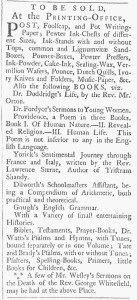What was advertised in a colonial American newspaper 250 years ago today?

“A Select Collection of Letters Of the late Reverend GEORGE WHITEFIELD.”
It was one of the biggest news stories of the year. George Whitefield died in Newburyport, Massachusetts, on September 30, 1770. The next day, newspapers in Boston informed colonizers of the death of one of the most influential ministers associated with the eighteenth-century religious revivals now known as the Great Awakening. Over the next several weeks, news spread throughout New England and to other colonies as printers exchanged newspapers and reprinted coverage from one to another. Those printers also sensed an opportunity to generate revenues by producing and marketing broadsides, funeral sermons, and books that commemorated the minister’s death. Throughout the colonies, but especially in New England, New York, and Pennsylvania, printers advertised commemorative items as they continued to publish updates about how colonizers near and far reacted to the news of Whitefield’s death.
Such advertising declined by the end of the year, but experienced a resurgence in the spring of 1771 when ships from England arrived in American ports with commemorative books and pamphlets published on the other side of the Atlantic. Printers and booksellers encouraged colonizers to participate in another round of commodifying Whitefield. That lasted for a couple of months before mentions of the minister faded from advertisements in the public print. That did not mean, however, that entrepreneurs believed that the market for such commodities had disappeared, only that it was no longer so robust. In the spring of 1772, Thomas Fleet and John Fleet, printers of the Boston Evening-Post, advertised “A Select Collection of Letters Of the late Reverend GEORGE WHITEFIELD … Written to his most intimate Friends, and Persons of Distinction, in England, Scotland, Ireland, and America.” The minister wrote those letters between 1734 and 1770, “including the whole of his Ministry.” In addition, the three-volume set contained “an Account of the Orphan House in Georgia” founded by Whitefield. In an advertisement in the April 13, 1772, editions of the Boston Evening-Post and the Boston-Gazette, the Fleets indicated that they “Just received” the books “by the last Ship from London.” Printers in England continued producing Whitefield memorabilia. Apparently believing that demand existed or could be cultivated for such materials on both sides of the Atlantic, they presented consumers with another opportunity to acquire printed items associated with the minister.









